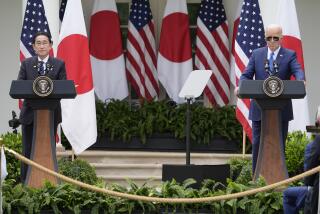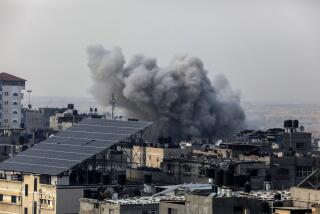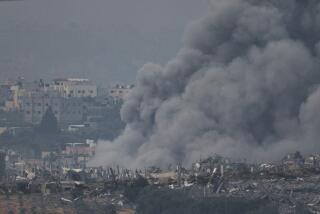Is U.S. Doing Too Little, Too Late in Helping Asia?
WASHINGTON — The Clinton administration is already under fire for being too late in recognizing--and in moving to contain--the Asian financial crisis. Now critics are asking a more fundamental question: Is it doing too little as well?
After this week’s meeting of Pacific Rim countries in Vancouver, Canada, many analysts are questioning whether the administration is marshaling sufficient resources to combat financial collapse in Asia and doing enough to prod Asian governments into making urgently needed economic reforms.
“The administration has been whistling past this graveyard for at least several months now without taking action,” says Alan K. Stoga,a Wall Street international economic strategist. “There’s a serious systemic problem here, and they’ve been miles and miles behind.”
The issue is important because, unless Asia’s financial problems are kept in check, the crisis could soon spread to engulf Latin America and eventually pose a risk to the U.S. economy. Brazil’s economy already is teetering. Others in the hemisphere also risk collapse.
Critics say Washington should assume the primary role, as it did in the 1982 Latin American debt crisis, in assembling financial rescue packages and by working vigorously behind the scenes to press financially troubled countries to engineer reforms.
There’s little question among outside analysts that the administration has been late in dealing with the problem. As Stoga points out, Asian financial markets have been in turmoil since summer; Thailand’s problems began showing up as early as February.
But when Thai markets finally collapsed, the administration passed on participating in the resulting rescue, leaving it to Japan to cobble together a bailout. And the U.S. was slow in anticipating the spread of the problem to Indonesia and other Southeast Asian countries.
While U.S. officials were instrumental in putting together the proposal developed in Manila that Pacific Rim leaders ratified Tuesday, the document is little more than a reaffirmation of the central role of the International Monetary Fund in handling future bailouts. The leaders made no pledges on specific steps.
The administration did face serious constraints in reacting to the Asian crisis.
Officials feared that Congress, miffed over the administration’s handling of the Mexican financial debacle in 1995, might move to block a U.S. bailout of the Thais. Senate Banking Committee Chairman Alfonse M. D’Amato (R-N.Y.) has opposed any such measures.
The administration also was facing a growing backlash over globalization and U.S. foreign economic policies. Lawmakers rejected its proposed “fast-track” legislation, which would have enabled it to negotiate trade treaties with other countries without fear that Congress would amend them.
And Jeffrey E. Garten, a former Commerce Department economic strategist and now dean of the Yale School of Management, said the administration had to keep a low profile at first, lest it set off a stampede of countries seeking bailouts “that might not be productive.”
But the administration still faces some daunting problems in trying to manage Asia’s turmoil:
* Even with the Manila plan, there is uncertainty whether the IMF and other lending agencies will have enough money to finance the necessary rescue packages if problems spread through Asia and Latin America.
* Plenty of work remains to be done in prodding troubled countries to take adequate steps to bolster their financial systems--and in pressing others that might be facing similar threats to move fast enough to stave off collapse. China, Malaysia and Hong Kong are all potential risks.
* The administration must make a special effort to push Japan, which has seemed paralyzed in the face of the current crisis, to manage the situation more effectively--by shutting insolvent banks and brokerages and by stimulating its domestic economy.
* Finally, Clinton must press Congress to pass unfinished legislation to increase the U.S. contribution to the IMF and grant the president new authority to negotiate trade treaties. The last has become an important symbol in efforts to coax Asian countries into keeping trade lines open.
The United States has more resources at its disposal than the budget may suggest. The Treasury maintains a $40-billion “exchange stabilization fund” that the Reagan administration had used routinely in the 1980s to make temporary loans to countries. And the Federal Reserve has a similar fund.
Still, outside analysts caution that, with the IMF cash pool now limited and Japan unable to help as much as it has in previous crises, there is a potential for coming up short if the turmoil spreads. South Korea alone is expected to require about $40 billion to $60 billion to shore up its economy.
W. Bowman Cutter, a former White House economic policymaker in the Clinton administration, points out that, as was evident in the 1982 debt crisis, only the U.S. has the economic power and political influence to manage a major global financial rescue program.
“Our role needs to be a lot more like the one we played after the Mexican crisis [in 1995] than it has been so far,” Cutter says. “And I think the American people have to understand why this situation is so scary.”
What makes it frightening is not so much the situation today as the risk that the slump in Southeast Asia could spread. Economists insist that the Asian crisis, as it stands now, will do only modest damage to the U.S. economy--and may even prove a blessing, by cooling the economy and preventing the Federal Reserve from having to raise interest rates to ward off inflation. Largely because of the Asian turmoil, the Fed left rates unchanged at its November meeting.
But if the turmoil spreads, the impact on the U.S. could be more severe: With Third World economies trying to boost their exports to the United States--and buying fewer American goods in return--the dollar would weaken, the interest rates here would rise.
And the dangers extend beyond the world’s economy to its political stability. The turmoil in South Korea, for example, could well alter the dangerous balance between South and North Korea, in an area where the United States has 37,000 troops.
The administration has already become more active. The plan that U.S. officials pushed through in Manila essentially nudged the rescue effort back onto the track that the administration wanted, staving off--at least for now--a retreat into protectionism.
Clinton’s appearance at the Pacific Rim conference was generally judged a success. The administration has been mulling ways to step up its efforts to manage the situation. Treasury Secretary Robert E. Rubin is to spread the message to Latin American officials in Santiago, Chile, next week.
On Wednesday, the White House reaffirmed that it plans to ask Congress to reconsider the $3.5 billion in new IMF lending authority that lawmakers rejected in October--though officials were unclear when and how the president intends to do that.
D’Amato still has not softened his opposition to a direct U.S. bailout, such as the one the president initially attempted when Mexico collapsed in 1995. But he publicly endorsed a rescue plan for Indonesia, which included offering $3 billion in temporary loans.
But Rep. Jim Leach (R-Iowa), chairman of the House Banking Committee, contends that Congress is likely to be more responsive in the face of a serious global economic crisis. He has urged the White House to propose a multibillion-dollar package that also would expand IMF coffers further.
Cutter warns, however, that to succeed at home and abroad, “the president has to be much, much more out front to educate the American public about why it matters”--a lapse that contributed to Congress’ refusal to pass the fast-track legislation.
Morris Goldstein, an analyst at the Institute for International Economics, says there is little choice but for the United States--via the IMF--to lead. Without proper management, he says, “you’ll sow the seeds for the next crisis.”
* TOKYO APPEAL: Japan made an unusual appeal to public, markets for calm. D1
* TRAVEL WOES: Turmoil sends airlines, and fares, into a tailspin. D1
More to Read
Inside the business of entertainment
The Wide Shot brings you news, analysis and insights on everything from streaming wars to production — and what it all means for the future.
You may occasionally receive promotional content from the Los Angeles Times.










